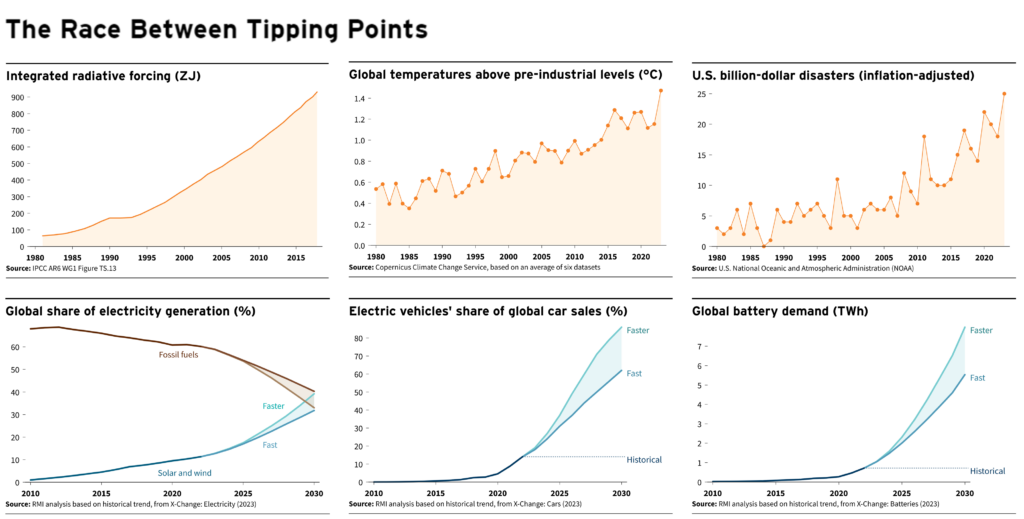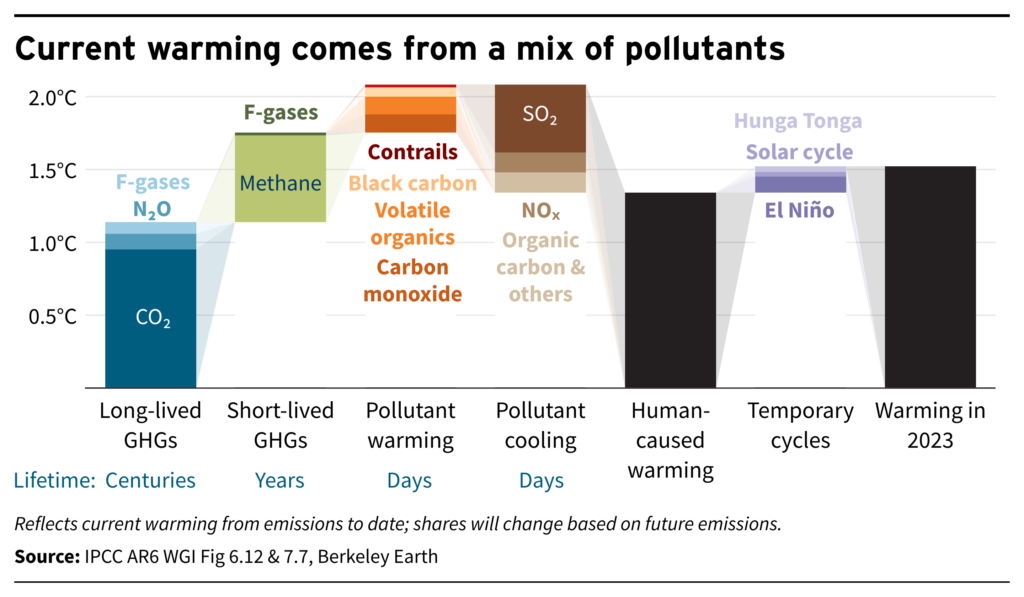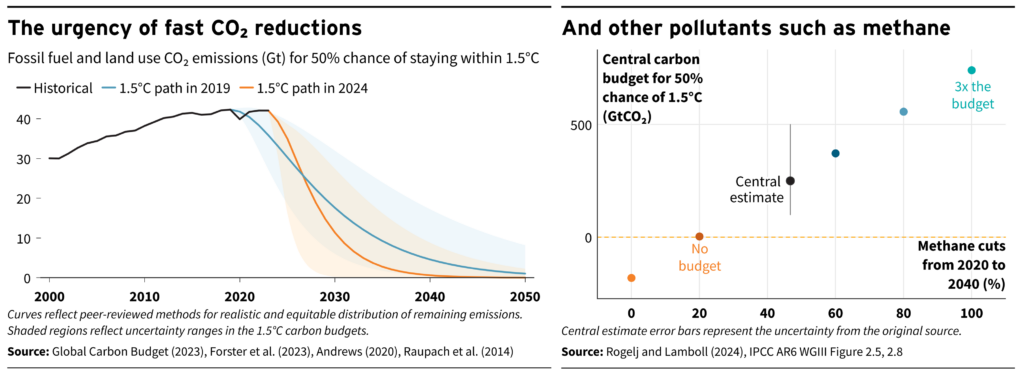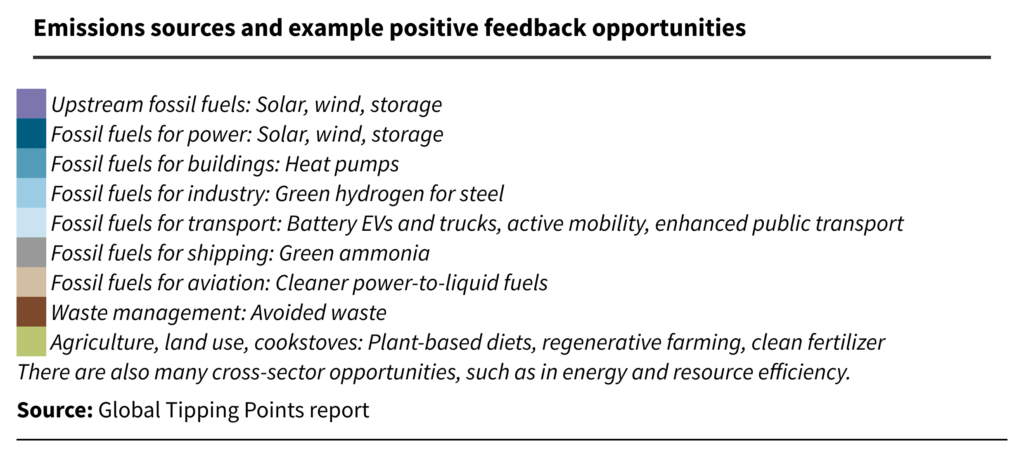
Record Temperatures, Record Solutions: The Fast-Changing Race for Our Future
We are in a race between tipping points — and as climate impacts accelerate, so too must climate solutions.
This week, climate research groups confirmed 2023 as the hottest year in recorded history — with global temperatures showing around 1.5°C of industrial-era climate change. That level may be temporary, but it would quickly become permanent if we fail to cut climate pollution — and every year of heat raises the risk of irreversible impacts.
Yet there are also positive feedbacks on the solution side — with exponential growth in clean energy along with promising cross-sector opportunities. As this race between tipping points accelerates, it’s an urgent reminder that later is too late to protect our planet for future generations.
The Risks of Climate Impact Tipping Points
If 2023 was a warning bell, it was a deafening one. Every month from June shattered records across air and sea temperatures — with nearly every day above 1.5°C of warming since pre-industrial times (1850–1900). Unprecedented warming led to unprecedented extreme weather, from turbo-charged storms in the Mediterranean and Pacific (fueled by warm waters) to devastating wildfires in Canada and Hawaii (fueled by dry heat). We can now attribute many of these events to human-caused climate change — including daily temperatures as well as annual costs of more than $100 billion in recent years.
The more years above 1.5oC and other planetary boundaries, the higher the risk of irreversible damage to key climate systems. According to hundreds of scientists in the Global Tipping Points report, several systems are already at risk under current temperatures — from coral reefs and boreal forests to the Greenland ice sheet and Arctic permafrost.
Potential impacts include harmful weather and warming as well as coastal flooding, food insecurity, and ecosystem disruption. Though none would lead to runaway warming, their impacts could cascade if some tipping points start tipping others. Rapid climate action is critical to reduce this risk.
To inform the action needed, it’s helpful to look where the warming is coming from. About 1°C comes from carbon dioxide (CO2), which causes the most long-term impacts due to its lifetime of centuries. Another ~1°C comes from methane and other pollutants, most of which would be gone in a day or a decade if we halt their emissions. That would make ~2°C of human-caused warming — but the net effect is lower due to other human-caused cooling (from air pollutants that reflect solar radiation). As these are reduced to avoid millions of annual air pollution deaths, it is crucial to limit the extra warming by curbing climate pollution as well.
As greenhouse gas emissions and concentrations continue to rise, researchers have found that the 1.5°C carbon budget could be exhausted in just five to seven years of current emissions. Previous scenarios that focused on net-zero CO2 by 2050 have been undercut by growing emissions — leading some to conclude that 1.5°C would require net-zero CO2 well before 2050.
But there still are scenarios that keep us within reach. The International Energy Agency highlights key steps by 2030 such as tripling clean energy deployment, doubling the rate of annual energy efficiency progress (starting now), and cutting energy-related methane by 75 percent. Meeting the efficiency target could bring half of this decade’s emissions cuts — while the extent of action on pollutants like methane could triple or squander our chances to meet climate goals.
The Power of Positive Tipping Points
Though climate impacts may be accelerating, so too is the clean energy revolution. As RMI research has found, 2023 was a record year for clean energy as well — with renewables exceeding 80 percent of new power capacity, EVs approaching one in five car sales, and grid battery storage deployments likely tripling. Methane action is also advancing, while Amazonian forest loss declined by half. Emissions may finally fall in 2024, as clean energy outpaces fossil fuels in key areas like China.
When solutions scale, they can spark positive feedback loops that accelerate adoption across the world. Researchers have found opportunities across emissions sources — including “super-leverage points” that can help multiple sectors by accelerating key technologies such as batteries and green hydrogen. Once key enabling conditions are unlocked via policy, finance, and infrastructure, these solutions can reach reinforcing feedback loops that improve with implementation. Then, they proceed to enable what few thought possible — like 600-mile EV ranges in China and six days of all-renewable power in Portugal.
The transition will require many efforts across energy, land use, and resilience — but by leading with modular solutions that have powerful network effects and proven S-curves, we can quickly curb climate pollution while preparing for the impacts that are already upon us. The faster we go, the faster we all benefit for health, safety, and more.
As people from island nations have been saying for years, “Our lived experience tells us we are running out of time.” It will take all of us to win that race and preserve the planet for our future.
Top image: This image was designed by Ed Hawkins (University of Reading) to show global temperature change since 1850. For more information, visit https://showyourstripes.info/




